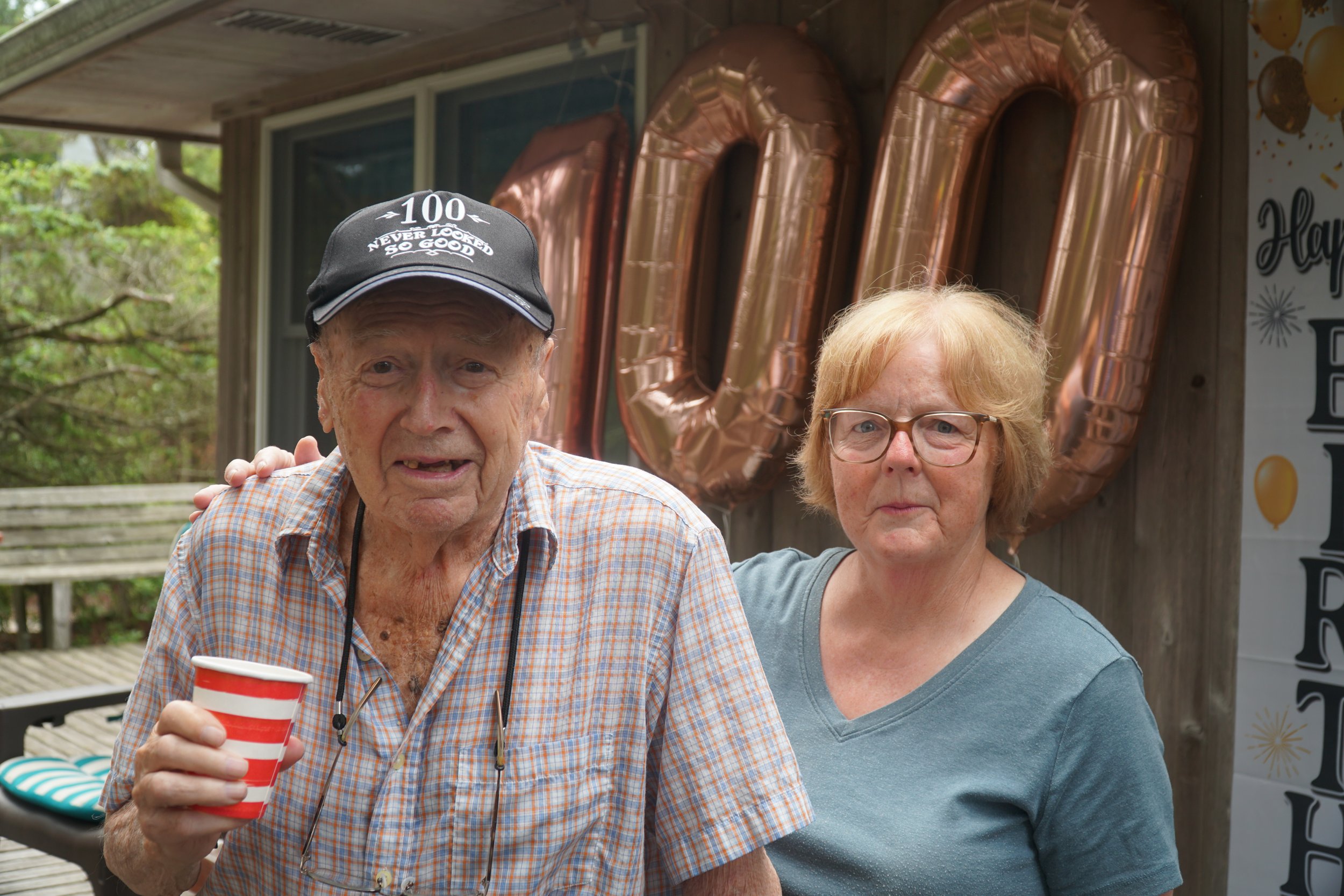
Warren James with his daughter Ellyn May, taken by Skylar Epstein.
On Sunday, July 2, Fair Harbor Fire Department (FHFD) personnel and dozens of local residents gathered at the home of Warren James to celebrate him on his 100th birthday.
The firefighters arrived in full gear in a convoy of FHFD vehicles. The crowd gathered on the narrow walk outside his home shimmying past the vehicles and jockeying to reach the newly minted 100-year-old for birthday hugs and handshakes. The crowd sang the birthday song and chanted “he’s a jolly good fellow.” Photos were taken and old stories and heartfelt speeches were shared.
FHFD Chief Brendan Reynolds said of the birthday festivities: “It’s important for our community to recognize a man who made Fire Island such a big part of his life.” Not only has James made Fire Island a big part of his life, he has witnessed and participated in the history of our island, and our country in general for a full century. After the party ended, Fire Island News spoke with Warren James and his adult daughter, Ellyn May, about his experiences over the last century in the hopes of documenting them and learning from them.
James first visited Fire Island in 1929 at the age of 6. Obviously in the decades since then he has witnessed immense changes both on and off Fire Island. James said that the big change between the Fire Island of his youth and the Fire Island of today is that there has been “a lot of expansion” in the interim. He added that he “liked it the old way better” when there were less walks, people, cars, and houses. The increase in development was not the only change James noted. He also said, “I never remembered deer here growing up as a kid but they’re here now,” and he noted the takeover of the island by the National Park Service.
One cataclysmic change to Fire Island that James witnessed was the aftermath of the 1938 hurricane. He spent the storm itself at his childhood home in Queens but came to Fair Harbor the following day with his father, William James, where he and James’ grandfather had houses. James said that he and his family actually rode the “Running Wild” to survey the damage, a ferry that he would become captain of later in life. The hurricane washed the two houses away from their original locations on the south side of Central Walk to near the bay. James said that he remembered Fair Harbor having roughly 100 houses before the storm and “like seven after that hadn’t moved.” His family’s houses had to be put on skids, lubricated with soap, and pulled back to their original locations using a tractor. “It works,” James said of the process. However, by the time the houses were back in place his grandfather had died.
A few years later James would dedicate five years of his life to the Coast Guard during World War II, serving in both the European and Pacific theaters. James told Fire Island News the story of the time a German submarine surrendered to the vessel he was serving upon. When Nazi Germany surrendered to the allies, James was in the middle of the Atlantic serving on a destroyer escort called the “USS Lansing.” A U-73 submarine, one of Nazi Germany’s most advanced submarines, surfaced in front of his convoy. The surrendering Nazi submarine was boarded and the boarding party cut off the hatch that kept water out of the submarine so it could not escape. In total James served on five ships during the war: the “USS Lansing,” “USS Eugene,” “USCGC Mistletoe,” “USCGC Spencer,” and “USCGC Ingham.” Today the “USCGC Ingham” is a museum ship in Key West, Florida.
After the war, James attended Pace Institute (today called Pace University) in Manhattan and studied accounting, which eventually became his career. During college, he became captain of “Running Wild” as a summer job for several years. At this time each Fire Island community had their own ferry company. Captain Elmont Patterson took over Ocean Beach’s ferry company and did not own enough boats to run it so he hired more boats to fill the gap. The “Running Wild,” a former rumrunner that James said was used during prohibition for smuggling alcohol before his time, became one of these boats. The ferry was owned by Gus Pagels and he paid James to pick up passengers for the Ocean Beach and Fair Harbor ferry companies. James’ mainland residence is a Bay Shore home that once belonged to Pagels. James married his wife, Lorraine, in 1950, which eventually put an end to his days as a ferry captain. “My wife didn’t like it,” he said of his ferry boat captain job, “because weekends were the times you get together and I’m out on the bay on the boat all the time.” He added that “she put up with it for a while.”
James also constructed his current Lonelyville home around this time. His father had purchased the land in anticipation of having to move his Fair Harbor home out of the way of Robert Moses’ proposed highway. However, the highway project was halted through the activism of angry Fire Island residents and the creation of Fire Island National Seashore so the land was still empty at the time. James asked his father for the land and his father gave it to him since he was his sole heir anyway. The land was originally two plots, but some of this was eventually taken in exchange for compensation by the Town of Islip via eminent domain in order to build the path that passes through Lonelyville today. Before this path existed, James recalls people simply wandering through their neighbor’s property in order to traverse the area.
James and his family have strong ties to the Fair Harbor Fire Department. His father was a member, and his dad’s badge number was 12. James for his part was elected Honorary Fire Commissioner for Lonelyville. At the time Lonelyville was not part of the Fair Harbor Fire District like it is today and instead paid for fire protection from Fair Harbor. Lonelyville later joined the Fair Harbor Fire District after the state changed its regulations to allow for non-contiguous fire districts. Prior to this change Dunewood’s insistence on maintaining its own fire district at the time was an impediment to Lonelyville joining Fair Harbor’s district. James’ history with the FHFD was remembered fondly at his 100th birthday celebration.
Today, James splits his time between Bay Shore and Lonelyville. He enjoys spending time on Fire Island with his children and grandchildren. He openly admits that he prefers the Fire Island that existed in his youth before decades of development and the national seashore reshaped the island and before it started “getting to be the place to come to,” as he put it. Still, when asked how he feels being able to spend time with family and grandkids on Fire Island today, almost a century after he first visited, he says it feels “wonderful, the kids love it.”
Hopefully he will get to spend many more birthdays on Fire Island in the years to come.


























